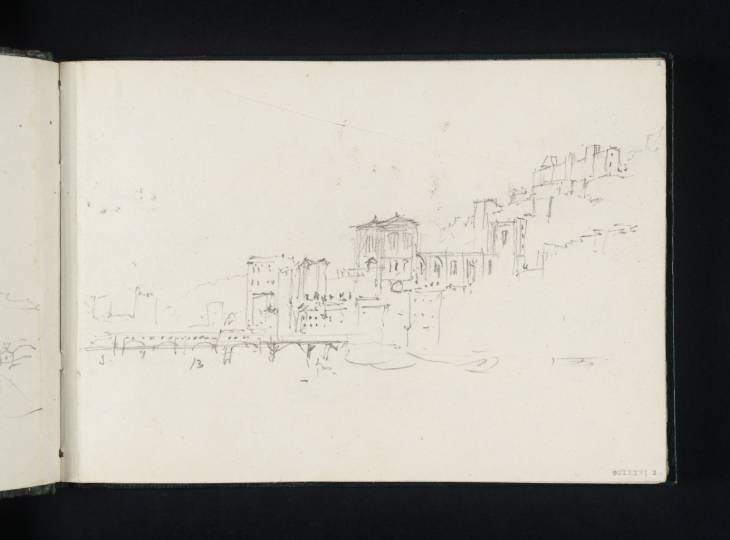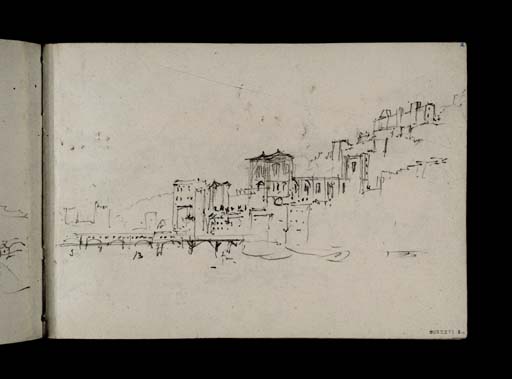Joseph Mallord William Turner The Cathedral of Saint-Jean-Baptiste with Bridges, Lyon 1828
Image 1 of 2
Joseph Mallord William Turner,
The Cathedral of Saint-Jean-Baptiste with Bridges, Lyon
1828
Folio 2 Recto:
The Cathedral of Saint-Jean-Baptiste with Bridges, Lyon 1828
D21767
Turner Bequest CCXXXVI 2
Turner Bequest CCXXXVI 2
Pencil on white wove paper, 125 x 171 mm
Inscribed in pencil by Turner ‘5’ and ‘13’ towards centre left, beneath the bridge
Inscribed in blue ink by John Ruskin ‘2’ top right and ‘2’ bottom right
Stamped in black ‘CCXXXVI 2’ bottom right
Inscribed in pencil by Turner ‘5’ and ‘13’ towards centre left, beneath the bridge
Inscribed in blue ink by John Ruskin ‘2’ top right and ‘2’ bottom right
Stamped in black ‘CCXXXVI 2’ bottom right
Accepted by the nation as part of the Turner Bequest 1856
References
1909
A.J. Finberg, A Complete Inventory of the Drawings of the Turner Bequest, London 1909, vol.II, p.723, CCXXXVI 2, as ‘Town, with river and bridges’.
The panoramic view of riverside buildings on this page extends onto folio 1 verso (D21766) opposite. In his 1909 Inventory of the Bequest, Finberg described this view as ‘Town, with river and bridges’, but was unable to pinpoint a more precise location.1 More recently, the geographer and Turner researcher Roland Courtot has identified the subject as the French city of Lyon.2
Turner’s vantage point, according to Courtot, is from the Pont du Change, which spans the River Saône. Facing south-west, he observed the Cathedral of Saint-Jean-Baptiste, located at the foot of the Fourvière hill on the right bank of the river, a building that dominates the centre of the page. Also in view are two bridges: furthest away is the Pont Bonaparte, completed in the 1800s. Later replaced, it was subsequently damaged during the Second World War and replaced once more with the current bridge, completed in 1950.3 The bridge in front of it appears to be the Passerelle du Palais de Justice, also replaced and reconstructed several times; the iteration depicted here by Turner is the wooden bridge completed by 1787, damaged in the 1820s and destroyed in 1833.4 Turner’s inscription ‘5’ likely refers to the five arches of the Pont Bonaparte, whereas the ‘13’ to the right presumably numbers the arches of the wooden bridge.
Together with folios 1 verso and 3 recto (D21766, D21769), which also depict Lyon, this study falls outside the geographical itinerary embodied by this Viterbo and Ronciglione sketchbook. Chronologically, these depictions of Lyon are also noteworthy as either the earliest or the latest sketches of Turner’s 1828–9 tour of France and Italy; it is unclear whether he sketched them on the outward or return leg of his journey.
Turner first sketched Lyon in 1802, and later in 1819–20 during his first major tour of Italy: for a list of relevant works, see Nicola Moorby’s entry in the Paris, France, Savoy 2 sketchbook of 1819 (Tate D14071; Turner Bequest CLXXIII 51).
Hannah Kaspar
December 2024
Roland Courtot, ‘12. Vers Rome: “Carnet de Viterbe et Ronciglione” (TB CCXXXVI)’, Carnets de voyage de Turner, accessed 15 July 2024, https://carnetswt.hypotheses.org/2312 .
‘Bridges of Lyon’, Wikipedia, accessed 2 August 2024, https://en.wikipedia.org/wiki/Bridges_of_Lyon .
How to cite
Hannah Kaspar, ‘The Cathedral of Saint-Jean-Baptiste with Bridges, Lyon 1828’, catalogue entry, December 2024, in David Blayney Brown (ed.), J.M.W. Turner: Sketchbooks, Drawings and Watercolours, Tate Research Publication, February 2025, https://www


